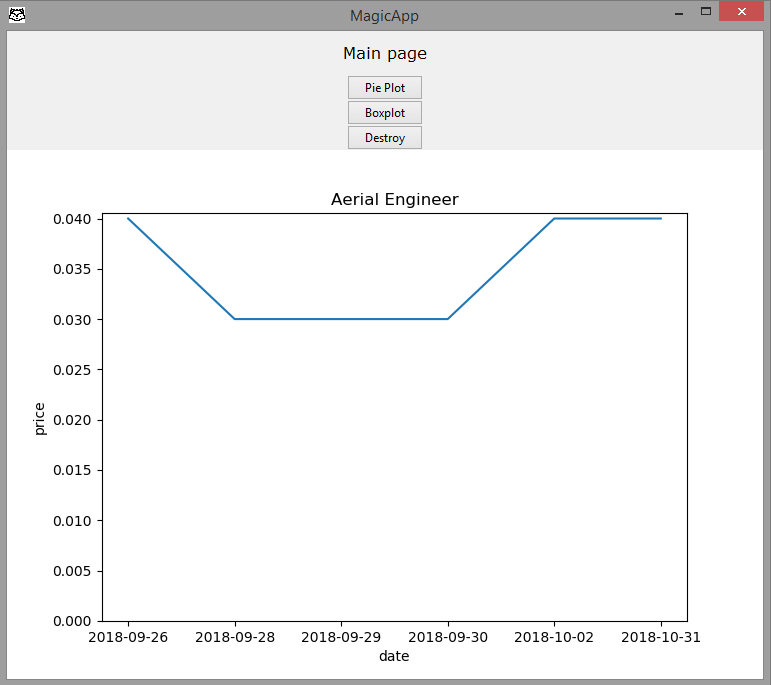Abandoned project: Data visualisation App with Magic the Gathering
Hello there!⌗
It’s been a while but I didn’t abandon this blog. However, I will talk today of an abandoned project of mine and why it still has value for me.
A great way to learn anything is having little projects. It helps confronts your theoretical knowledge to reality and make you resolve problems. As a self-taught hobbyist programmer it’s especially important to me, because it’s the only form of evaluation I can get. You could conclude that only results matters then, but it’s not entirely true.
I started this project last year with some objective in mind:
-
Would contain data visualisation
-
Fun
-
Learn new things
-
Really challenge myself with something outside my comfort zone
Chosing a project⌗
I was working at the time on my thesis and I was fed of blood levels. I still wanted to cash in my newly acquired pandas and matplotlib skills and I stumbled upon this series of tutorials on PythonProgramming.net, to make a Bitcoin trading app with Python and Tkinter. Fun, but not fun enough. At this time, i started playing Magic the Gathering, a successfull collectible card game. Due to the popularity of the game and their business model, people trade cards and their price varies depending on their popularity and the stocks. I would make a data viz app, about Magic the Gathering prices!
Gathering Data (requests to scryfall)⌗
First, I needed data. Where to get the list of cards, their name, prices and different attributes such as rarity? Fortunately for me, there is a good number of websites that provides this. I chose https://scryfall.com. Here was the first difficulty for me. As a biologist, you never learn what is an API. Quickly enough I was able to build the request I wanted to get a nice JSON (scryfall have a Rest-like API) that I can convert to a Pandas Dataframe. From there it’s easy to build some visualization and following the Tkinter tutorial. However, I had huge troubles adapting/understanding how Tkinter animates as I wanted buttons to modify the type of visualization/subset of data without surimposed them. With some horrible fidgeting, I would destroy and recreate a canvas and have something sorta functional.

Storing the data (Redis)⌗
Another problem was to get daily prices. I needed to actualize the price every day, and keep them for history. I didn’t want to learn a whole database system, so I needed something light and easy. Redis was the best choice in my opinion. It’s a system that can be used as a database that store what you want as key/value. Luckily I could get a unique identifier for any magic card, I just had to pull the price everyday and I could store like ID : (date, price), with simple function to convert Dataframes to redis and vice versa. It can be done in a few lines:
import redis
import datetime
import pandas as pd
r = redis.Redis(host="redis_price", port=6379, decode_responses=True)
def get_all_redis_hash(df):
"""
Set the price of today, in redis server, as card id : date : price
:param df: pandas DataFrame with card id and price from scryfall
"""
today_date = datetime.date.today()
for _ in df['id']:
price = float(df.loc[df['id'] == _]['usd'].values)
r.hset(_, today_date, price)
def get_price_list_from_redis(card_id):
df = pd.DataFrame.from_dict(r.hgetall(card_id),
orient="index", columns=['price'])
df['price'] = df['price'].astype('float', copy=False)
df.index.name = 'date'
return df
What’s fun looking back at old project is looking at your old mistakes. I recently read Clean Code which is a book teaching some principles of good software programming. I can now notice how my comments are unnecessary and the naming is horrid. Looking back at your old projects is also a lot of cringes. But it helps you see how you progressed?
Get the data each day (schedule and Docker)⌗
Next step was to pull them every day. It’s easy enough with schedule.
from app.redis_price_server import get_all_redis_hash
import schedule
from app.card_fetcher import get_all_standard
print("Scheduler launched!")
schedule.every().day.at("15:00").do(get_all_redis_hash(get_all_standard())
But then i realize, that this is working only on my computer. I would need to let this script forever goes and never close my computer. So the next logical step would be to deploy all of this on a server. So i learn docker, i play with it a bit and manage to launch an image that pulls the price, the redis server and the automated script.
End of the line⌗
I then understand that i’ve made the wrong choices, that i can’t launch my Tkinter app in this and that was a terrible idea. Combining with the problem i had to make Tkinter and Matplotlib more reactive, i realise that i should then orient myself towards a web application.
Unfortunately, i would have to learn bokeh (who looks amazing) or even something in Javascript to make it functional. (However, Mozilla is working on bringing python dataviz tools to the web. Check Pyodide if you’re curious.) Since i don’t know anything about web development i decided to stop the project there. It was definitely becoming too big for what i wanted initially.
Were all those hours lost? No. Look up to my objectives. I manage to practice data manipulation, GUI, Redis, Docker, schedule and also Rest-like API. I went far beyond my comfort zone and this made me definitly better. Looking at it now and i’m thinking of all the ways i could have make it better. So even if i didn’t deliver in the end, i’m proud of the result and i feel like it made me a better programmer.
Next blog post will be about a project that did succeed ;).
Stay tuned and goodbye dear reader.